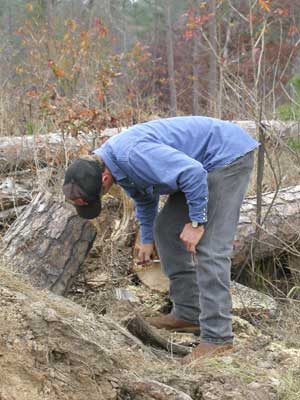
Getting Started
We knew that the timbers to be used in this project were larger than typical due
to the significant span (over 50 feet) of the timber trusses. As such, it took some
time and effort to locate the larger logs required to produce these timbers. John
Box, our sawyer, has been working with our suppliers and other Texas foresters to
locate these logs. We have located a tract along the Neches River in Trinity County
that will supply the majority of the logs used in this project and if the weather
holds, we should have little difficulty harvesting the logs we need.

|
Meet Tim Chauvin, president of Red Suspenders Timber Frames. Tim and Steve
Lucchesi, of Hall, Barnum & Lucchesi Architects, worked together to
determine some of the architectural details to be incorporated in the chapel timber
frame. From these initial designs, Tim produced the "Shop Drawings" and
all the joinery details that will be used to actually fabricate the chapel timber
frame. Southern Yellow Pine
was specified as the wood of choice for the frame construction
The shop drawings were submitted to Ben Brungraber, Ph.D., PE, for computer
analysis. Ben's expertise in testing timber frame designs is well known in the industry.
The shop drawings received final approval from Ben, having passed all engineering
requirements unchanged, in early January, 2002.
|
|
Meet Mr. John Box, sawyer, of Red Suspenders. John is a master at picking
the right logs for timber frame applications. John's task is to locate Southern
Yellow Pine logs of the right quality and size for the chapel and to produce the
timbers needed to construct the chapel frame. John works from a "cut list"
that Tim produces from the shop drawings. The specifications we require for logs
are very detailed. As few as 1 in 10 trees on a parcel of land will be of sufficient
quality to obtain the logs we specify.
Ask a question:
Tell me more about Southern Yellow Pine.
|

|

|
We work with many foresters and loggers who harvest from many different tracts of
land. This tract, known as the Borders Tract, is located along the Neches River
in Trinity County Texas, and is part of some 700 acres of forest land under active
management. Southern Yellow Pine is harvested from the area on a rotating basis
to preserve the health of the land and its natural resources. This tract has produced
logs of very good quality in the past. The logs you see here were selectively harvested.
|
|
Access to the site is typical for a logging operation in dry weather. Heavy or continuous
rains will halt most harvesting because it makes the site difficult to work. More
importantly, soggy conditions are avoided because the heavy equipment could damage
the land itself. Ruts and "wallows" created by heavy logging equipment
on wet ground can cause erosion and damage the root systems of trees not harvested.
Root damage can stress a tree and stunt its growth. It could also make the tree
more susceptible to disease.
The Southern Yellow Pine trees you see behind the logging skidder are not ready
for harvesting. The trees that meet our quality standards are located along the
river bottom area on this particular tract.
|

|

|
John measures the diameter of a specimen Southern Yellow Pine log and counts the
growth rings to determine the age of the tree. The more dense (closely spaced) the
growth rings, the more stable the material sawn from the log. This tree is about
14" in diameter and appears to be about 64 years of age.
The logs we use must be straight, free of defects, like branches which will show
up as knots in the timbers, have even and concentric growth rings, and taper uniformly
from top to bottom. Only logs meeting these specifications will produce the quality
timbers we require.
|
|